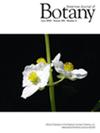亚热带附生蕨类植物 Ophioderma pendulum 根部普遍存在的丛生菌根和叶片中高度多变的菌生物群
IF 2.4
2区 生物学
Q2 PLANT SCIENCES
引用次数: 0
摘要
前言内生真菌和菌根真菌在促进植物获取营养和承受压力方面至关重要。在附生生境中,植物面临着营养和水分胁迫,但它们的根大多没有菌根,尤其缺乏丛枝菌根。摆尾蕨(Ophioderma pendulum)是一种附生蕨类植物,具有部分菌根营养的生活方式,很可能严重依赖共生真菌。方法对亚热带森林中的根和叶进行显微镜检查,观察真菌结构的形态,并确定寄主组织中各种真菌结构的比例。使用以核核糖体 DNA 的 ITS2 为目标的代谢编码技术分析了真菌的组成。结果根部一直被丛枝菌根真菌(球菌纲)定殖,尤其是 Acaulospora。与以前对附生蕨类植物的研究结果不同,摆尾蕨根部很少有深色隔膜内生菌。叶片主要由子囊菌群真菌定殖,特别是 Dothideomycetes(46.88%)、Eurotiomycetes(11.51%)、Sordariomycetes(6.23%)和 Leotiomycetes(6.14%)类。不同采样点的根部真菌群落组成相似,但叶片的真菌群落组成差异显著。结论摆线木霉在根部保持稳定的、单一菌群的优势群落,主要以丛枝菌根真菌为主,而叶片可能藏有机会性真菌定殖者。我们的研究强调了菌根真菌在附生蕨类植物适应过程中的重要性。本文章由计算机程序翻译,如有差异,请以英文原文为准。
Prevalent arbuscular mycorrhizae in roots and highly variable mycobiome in leaves of epiphytic subtropical fern Ophioderma pendulum
PremiseEndophytic and mycorrhizal fungi are crucial in facilitating plant nutrition acquisition and stress tolerance. In epiphytic habitats, plants face nutrition and water stress, but their roots are mostly nonmycorrhizal and especially lacking in arbuscular mycorrhizal associations. Ophioderma pendulum is an epiphytic fern with a partially mycoheterotrophic lifestyle, likely heavily reliant on symbiotic fungi. To characterize fungal associations in the sporophyte of O. pendulum , we focused on leaves and roots of O. pendulum , seeking to reveal the fungal communities in these organs.MethodsRoots and leaves from O. pendulum in a subtropical forest were examined microscopically to observe the morphology of fungal structures and determine the percentage of various fungal structures in host tissues. Fungal composition was profiled using metabarcoding techniques that targeted ITS2 of the nuclear ribosomal DNA.ResultsRoots were consistently colonized by arbuscular mycorrhizal fungi (Glomeromycota), especially Acaulospora . Unlike previous findings on epiphytic ferns, dark septate endophytes were rare in O. pendulum roots. Leaves were predominantly colonized by Ascomycota fungi, specifically the classes Dothideomycetes (46.88%), Eurotiomycetes (11.51%), Sordariomycetes (6.23%), and Leotiomycetes (6.14%). Across sampling sites, fungal community compositions were similar in the roots but differed significantly in the leaves.ConclusionsOphioderma pendulum maintains stable, single‐taxon‐dominant communities in the roots, primarily featuring arbuscular mycorrhizal fungi, whereas the leaves may harbor opportunistic fungal colonizers. Our study underlines the significance of mycorrhizal fungi in the adaptation of epiphytic ferns.
求助全文
通过发布文献求助,成功后即可免费获取论文全文。
去求助
来源期刊

American Journal of Botany
生物-植物科学
CiteScore
4.90
自引率
6.70%
发文量
171
审稿时长
3 months
期刊介绍:
The American Journal of Botany (AJB), the flagship journal of the Botanical Society of America (BSA), publishes peer-reviewed, innovative, significant research of interest to a wide audience of plant scientists in all areas of plant biology (structure, function, development, diversity, genetics, evolution, systematics), all levels of organization (molecular to ecosystem), and all plant groups and allied organisms (cyanobacteria, algae, fungi, and lichens). AJB requires authors to frame their research questions and discuss their results in terms of major questions of plant biology. In general, papers that are too narrowly focused, purely descriptive, natural history, broad surveys, or that contain only preliminary data will not be considered.
 求助内容:
求助内容: 应助结果提醒方式:
应助结果提醒方式:


